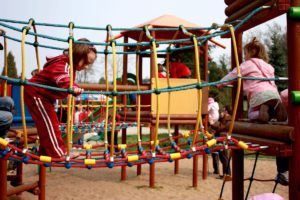Getting children to spend more time outside is essential for their overall well-being. Providing the right outdoor play equipment allows kids to stay active while enjoying a fun and engaging environment. Whether in a backyard, school playground, or community park, having access to high-quality children’s play park equipment encourages movement, creativity, and social interaction. Well-designed play spaces encourage physical activity while also helping children develop essential life skills through play.
The Importance of Active Play
Outdoor play is a crucial part of a child’s development. It improves physical health by promoting movement, balance, and coordination while reducing the risks associated with a sedentary lifestyle. Running, jumping, and climbing help strengthen muscles and bones, contributing to overall fitness. Engaging in outdoor activities also enhances motor skills, spatial awareness, and flexibility, all of which play a role in a child’s growth.
Beyond the physical benefits, active play fosters cognitive and emotional development. It encourages problem-solving, decision-making, and social skills as children interact with their peers. Whether they are inventing games, building confidence through new challenges, or learning teamwork, outdoor play offers more than just exercise—it provides an opportunity for learning and exploration.
Choosing the Right Outdoor Play Equipment
Creating an inviting and safe outdoor play space starts with selecting the right equipment. There are many options available, ranging from classic swings and slides to interactive climbing structures and obstacle courses. The best play areas feature diverse activities that accommodate various interests and energy levels, allowing children of all ages and abilities to take part. A well-balanced playground includes equipment that encourages different types of movement. Swings help develop balance and coordination, climbing walls build strength and problem-solving skills, and slides provide sensory stimulation and confidence-building experiences. Interactive features like spinning elements or rope bridges add extra excitement, keeping children engaged for longer periods.
It’s also important to consider the durability and materials of the play structures. Metal equipment is sturdy and long-lasting, while wooden structures provide a natural aesthetic and can blend seamlessly into park environments. High-quality plastic is often used for toddler-friendly playsets, ensuring safety and weather resistance. Choosing age-appropriate equipment guarantees that children can play comfortably without unnecessary risks.
Creating a Safe Play Environment

While outdoor play is essential, safety should always be a priority. The placement and design of children’s play park equipment should focus on minimizing hazards and creating a secure play space. Proper spacing between structures prevents overcrowding and reduces the risk of collisions. Ensuring that swings, slides, and climbing frames are set up with enough clearance allows children to move freely without interfering with one another.
Soft, impact-absorbing surfaces beneath play structures significantly reduce the likelihood of injuries. Grass, wood chips, rubber mulch, and sand are some of the best options for playground flooring, offering cushioning in case of falls. Avoiding hard surfaces like concrete or asphalt makes play areas safer and more comfortable for children.
Equipment should also have built-in safety features, such as smooth edges, non-slip surfaces, and sturdy handrails. Regular maintenance is essential to check for loose bolts, worn-out swings, or rusting metal components that could pose a risk. Keeping play areas clean and well-maintained ensures a long-lasting and safe environment for kids.
Encouraging Outdoor Play Through Design
A well-designed play space is inviting and encourages children to stay active for longer. Colourful and engaging designs spark creativity, while shaded areas allow for comfortable play, even on warm days. Incorporating natural elements, such as logs, tree stumps, or small gardens, adds variety and allows children to connect with nature while playing.
Public parks and school playgrounds can benefit from a mix of structured and open-ended play opportunities. While outdoor play equipment provides structured activities, open spaces for running, ball games, or creative play encourage children to use their imagination. Combining both elements leads to a dynamic and engaging outdoor environment.
Adding seating areas for parents and caregivers also contributes to a welcoming play space. Comfortable benches or picnic areas encourage family outings and social gatherings, making the playground a central part of the community.
Incorporating Physical Challenges for Development
One of the best ways to promote active play is by incorporating physical challenges that encourage children to test their abilities. Climbing frames, monkey bars, balance beams, and rope courses are excellent for improving strength, agility, and endurance. These types of challenges build confidence and determination, allowing children to push their limits in a safe and controlled setting.
Playgrounds with a variety of difficulty levels cater to different age groups and skill sets. Toddler-friendly play areas with gentle slides and small climbing structures ensure safe exploration, while older kids benefit from more complex features like tall climbing nets or advanced obstacle courses. This inclusive approach keeps children engaged and ensures that they remain active as they grow.
Encouraging Group Play and Social Interaction
Outdoor play is not just about physical movement—it also helps children develop essential social skills. Group activities, such as seesaws, cooperative climbing structures, and team games, encourage kids to interact, share, and work together. Learning how to take turns, resolve conflicts, and communicate effectively happens naturally in a playground setting.
Playgrounds that incorporate interactive elements, such as talking tubes, group swings, or shared balancing equipment, create opportunities for teamwork and collaboration. Encouraging group play also helps children build friendships, develop empathy, and gain confidence in social situations.
The Role of Parents and Caregivers
Parents and caregivers are essential in motivating children to engage in active outdoor play. Leading by example and participating in activities alongside children creates a positive attitude toward movement and exercise. Even simple activities like kicking a ball, pushing a swing, or running alongside a child on the playground help reinforce the importance of physical activity.
Limiting screen time and promoting outdoor activities help create a healthy balance between indoor and outdoor play. Organizing trips to the park, nature walks, or backyard games provides children with regular opportunities to be active. Schools and community organizations can also support outdoor play by hosting outdoor events, sports days, or playgroup activities that engage children in movement-based fun.
Encouraging a Lifelong Love for Outdoor Activity
Fostering a love for outdoor play early on supports the development of an active and healthy lifestyle. Playgrounds and parks offer children a space to run, jump, and climb freely, helping them develop essential skills and habits that carry into adulthood. A positive outdoor play experience fosters curiosity, exploration, and a sense of adventure.
By providing safe, engaging, and well-maintained children’s play park equipment, communities and families create spaces where kids can thrive physically, socially, and emotionally. Making outdoor play a priority ensures that children not only enjoy their time outside but also build lasting memories, friendships, and a strong foundation for lifelong health and well-being.




